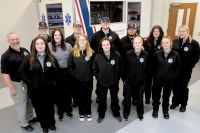Keep your eye on the birdie
Last year around this time we talked about York University Professor Bridget Stutchbury’s groundbreaking research with migrating purple martins and wood thrushes (see http://www.smokymountainnews.com/index.php/news/item/1383-the-naturalists-corner).
Stutchbury, her students and now other researchers — with the aid of some nano-technology — are opening new windows on the world of bird migration. The new technology is in the form of geolocators. These tiny “backpacks” designed by the British Antarctic Survey can weigh as little as 1.1 gram, making them small enough to place on songbirds such as thrushes and martins. The geolocators are held in place at the base of the bird’s spine by small straps around the bird’s legs. The geolocators detect light and allow researchers to estimate a bird’s latitude and longitude by recording sunrise and sunset times.
The accuracy of the geolocators is within 180 miles.
At first glance, plus or minus 180 miles might not seem like pinpoint accuracy, but when you figure you’re tracking a mobile eight-inch object over a linear distance of 4,000 miles and you can not only estimate its location but determine the direction of its movement, it’s pretty amazing.
Results from Stutchbury’s research are already turning the ornithological world on its ear. Stutchbury told Science Watch in a September 2010 interview featuring innovations in research, “Data from the geolocators indicated that songbirds can fly in excess of 500 km (311 miles) per day whereas previous studies using other methods estimated their flight performance at roughly 150 km (93 miles) per day.”
Her research also showed marked differences between fall and spring migration: “We found that songbirds’ overall migration rate was two to six times more rapid in spring than in fall. For example, one purple martin took 43 days to reach Brazil during fall migration, but in spring returned to its breeding colony in only 13 days.”
Related Items
Stutchbury has expanded her collaboration with the Purple Martin Conservation Association and other researchers to include martins in British Columbia, Texas and Virginia. She hopes to discover, “… how breeding populations map onto wintering sites in South America and how migration distance and breeding location affects migration routes and timing.”
Stutchbury told Science Watch that being able to track migrants to and from their wintering and breeding grounds is paramount to bird conservation:
“Many migratory songbirds are undergoing long-term population declines, in large part due to winter habitat and stopover site loss. Identifying the stopover and wintering sites of specific breeding populations is critical for understanding how breeding versus over-wintering events contribute to population declines.
“Knowing where breeding populations spend the winter, and vice versa, is critical for focusing conservation efforts in regions where they are needed most, and for establishing new and more effective international partnerships in migratory songbird conservation.”
Geolocators are also being used to study migration patterns of threatened and/or endangered birds like the red knot, roseate tern and piping plover.
Don Hendershot can be reached at This email address is being protected from spambots. You need JavaScript enabled to view it.













